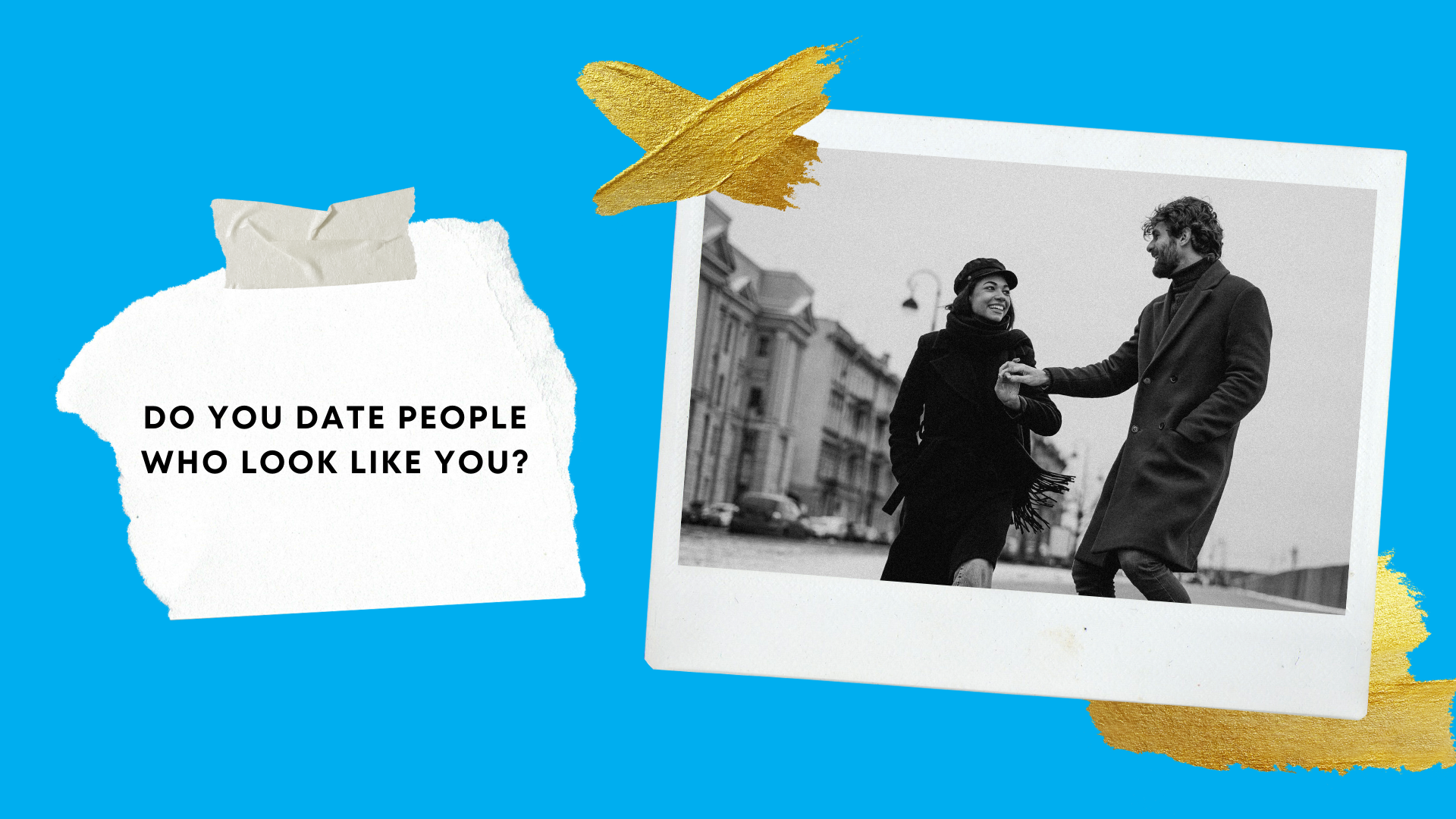Opposites attract, right? Well–not always. Have you noticed that the partners in some couples look strikingly similar to each other? ‘How narcissistic’, one might think…but actually, there’s a biological basis for this trend, and it isn’t narcissistic at all. On the contrary, it’s quite natural.
A growing body of research as of late has shed light on this phenomena. In one study, subjects were shown a picture of a stranger, followed by a picture of themselves morphed with the stranger. They were then asked to rate these portraits for attractiveness. They consistently rated the stranger morphed with themselves as more attractive than the stranger (Perina, 2015).
Perhaps even more shockingly, people are far more likely to fall for someone if that someone looks similar to their opposite-sex parent (Perina, 2015). Another study substantiated this claim by showing research participants a quick glimpse of their opposite-sex parent followed by a picture of a stranger, while some other subjects did not get the glimpse of their opposite-sex parent and saw only pictures of the stranger. Those who saw the photo of their parent first were more likely to assign a higher attractiveness rating to the stranger because the photo of their parent (who presumably they find attractive, at least unconsciously) ‘primed’ them to feel that the stranger was attractive (Perina, 2015).
What might surprise you even more is the biological reason researchers think people are attracted to similarity. One study conducted in Iceland found that when third or fourth cousins married, they tended to produce more offspring than completely unrelated partners. These researchers posited that this could be because third and fourth cousins actually have the most optimal degree of genetic similarity for producing a strong gene pool. People who are too closely related are at a higher risk for genetic abnormalities as a result of inbreeding, whereas completely unrelated individuals may have genetic incompatibilities (Perina, 2015).
Social psychologist Justin Lehmiller, on the other hand, explains the prevalence of lookalike couples in another way: We humans naturally gravitate towards what’s familiar. You are very familiar with how you look, so by extension it’s only natural that you are drawn to people who share similar features (Ducharme, 2019). There are also multiple studies which suggest that spouses frequently have a high degree of genetic similarity and often share genetic predictors of a range of traits, such as height and even educational attainment (Ducharme, 2019), further evidencing the theory that we are unconsciously drawn to similarity.
Genetic similarity and preference for the familiar are not the only reasons for lookalike couples, though. Some couples that look alike today didn’t used to in the past; this is often the case with older married couples. A 1987 study that explored this phenomenon theorized that years upon years of shared emotions result in couples looking similar because their shared experiences have led to making similar facial expressions (again and again) and therefore developing similar wrinkles, which make their faces appear more similar over time(Ducharme, 2019).
There are also findings suggesting that people may be predisposed to attraction to partners coming from similar ancestry. However, the study’s authors also found that most groups were progressively less likely to marry within their own ancestral group with each successive generation (Sebro et. al, 2017). This may be due to the fact that couples today tend to marry later in life and travel more for work, education, and leisure. All this extra time and experience gives them more opportunities to get together with genetically-dissimilar partners than in the past, when people may married within their ancestral groups at least partially function of having access only to their own groups.
The Role of Online Dating
Dating apps are both reinforcing similarity biases and allowing users to transcend them. On the one hand, online dating gives people access to a vast array of potential matches to whom they wouldn’t have otherwise been exposed. This allows them to select dissimilar individuals despite the fact that in real life they may be surrounded by people bearing more similarities, simply as a result of many people living in homogeneous environments that also often produce more genetically and visually similar individuals.
On the other hand, the sheer amount of options online daters are given means that people can browse through potential mates in search of those bearing similarities. Also, many dating apps allow users to filter results based on race and ethnicity (Lefkowitz, 2018), further boosting the likelihood of one ending up with a similar-looking partner.
You Need a Prenup (No Matter How Similar You Are)
If you do end up with a partner who looks similar to you and/or is similar to you in other noteworthy ways, you may take your similarities for granted and tend to overlook or downplay differences. However, even if you’re highly similar in a multitude of ways, you’re still two separate individuals who are unable to read one anothers’ minds and unlikely to agree on everything. And guess what that means? You still need a prenup. Even if you’re wildly similar. A prenuptial agreement helps you to communicate about and plan how your finances will be managed during marriage. It also allows the two of you to dictate for yourselves how assets should be allocated in case of divorce (instead of letting the state decide for you based on some arbitrary one-size-fits-all approach that you might not necessarily agree with).
Even couples who are very similar are not immune to relationship breakdown and divorce, although some similarities may boost your odds. The predictors of a happy marriage go well beyond just similarity. If you consider yourself similar to your partner, make sure you don’t rely on that too heavily and end up missing important relationship skills, such as skillful conflict management and good listening skills (an extremely important and underrated relationship skill). The unfortunate reality is that around half of all couples who get married eventually divorce. We hope this will never be you, but it’s important not to deny this possibility because if you do later divorce and you did not get a prenup, the result may be disastrous for one or both of you. We recommend writing a prenup and also continually fortifying your marriage by educating yourselves on relationship skills and couple’s psychology and even trying couple’s therapy as a way to manage conflict, learn more about yourselves and each other, and strengthen your relationship. With a little bit of awareness and education, your prenup will remain forever in a drawer gathering dust.
It’s hard to say whether the prevalence of lookalike couples and couples who exhibit other innate similarities will decrease or disappear as a result of more opportunities for travel, later marriage, online dating, and other modern-day trends in dating and marriage–but ultimately, is it actually that important? We think that what is more important is that we exhibit tolerance towards all consensual relationship choices. We would do well not to condemn couples that look similar or who are otherwise similar for being ‘narcissistic’, and to equally accept interracial couples or those who are dissimilar in other ways, from socioeconomic class and educational background to age and nontraditional relationship types.
References
Ducharme, J. 2019. Why Do So Many Couples Look Alike? Here’s the Psychology Behind the Weird Phenomenon. Retrieved from: https://time.com/5553817/couples-who-look-alike/
Lefkowitz, M. 2018. Redesign Dating Apps to Lessen Racial Bias, Study Recommends. Retrieved from: https://news.cornell.edu/stories/2018/09/redesign-dating-apps-lessen-racial-bias-study-recommends
Perina, K. 2015. Are We Attracted To People Who Look Like Us? Retrieved from: https://www.psychologytoday.com/us/blog/the-mysteries-love/201505/are-we-attracted-people-who-look-us
Sebro, R., Peloso, G. M., Dupuis, J., & Risch, N. J. Structured Mating: Patterns and Implications. Retrieved from: https://journals.plos.org/plosgenetics/article?id=10.1371/journal.pgen.1006655#sec020

Julia Rodgers is HelloPrenup’s CEO and Co-Founder. She is a Massachusetts family law attorney and true believer in the value of prenuptial agreements. HelloPrenup was created with the goal of automating the prenup process, making it more collaborative, time efficient and cost effective. Julia believes that a healthy marriage is one in which couples can openly communicate about finances and life goals. You can read more about us here Questions? Reach out to Julia directly at [email protected].

0 Comments